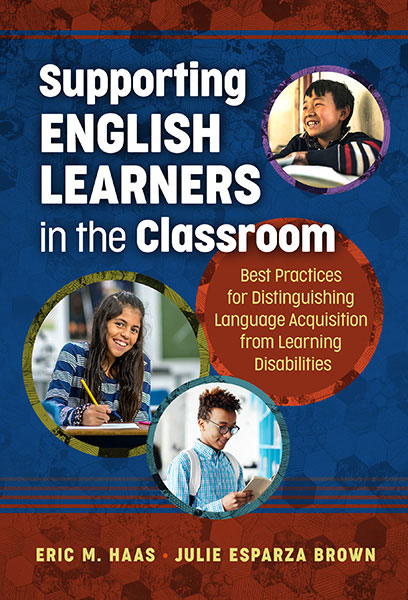Professors: Request an Exam Copy
Print copies available for US orders only. For orders outside the US, see our international distributors.
Eric M. Haas, Julie Esparza Brown
Publication Date: May 3, 2019
Pages: 240

In this important resource, educators will find evidence-based best practices to help them address the individual needs of English learners with academic challenges and those who have been referred for special education services. The authors make the case that systems can be put in place at three levels to help English learners succeed: the classroom level, before and after identification; the support-team level, when support plans are developed and assessed; and the system level, where programs and professional training plans should be continually developed, assessed, and revised. Putting theory into practice, this book offers guidance and specific tools to help districts, schools, and classrooms use Multi-Tiered System of Supports (MTSS) and other interventions to promote higher levels of achievement for ELs with academic challenges or learning disabilities.
Book Features:
Eric M. Haas is a professor and director of the educational leadership doctoral program at California State University, East Bay. Julie Esparza Brown is an associate professor in the Department of Special Education at the Graduate School of Education, Portland State University.
“…expertly organized and presented, making it an ideal and unreservedly recommended addition to school district in-service training curriculums, as well as college and university library Teacher Education instructional resource collections.”
—Midwest Book Review
“This book helps fill a gap by providing a Multi-tiered Systems of Support framework that is culturally and linguistically responsive. The authors identify what all educators, including assessment and instructional personnel, need to know in order to ensure the success of English learners. They provide excellent guidance for meeting the complex needs of English learners with true learning disabilities. An outstanding resource for practitioners and researchers alike.”
—Alba Ortiz, professor emeritus, The University of Texas at Austin
“This is a wonderful resource for those who have the opportunity to serve English learners in the classroom, including those with academic challenges."
—Martha Thurlow, director, National Center on Educational Outcomes, University of Minnesota
“Readers of this book will find practical guidance and tools grounded in the latest research for teaching English learners. The authors unpack complicated issues such as the assessment and referral process and offer guidance for making difficult decisions based on data. This book will help readers provide culturally and linguistically responsive instruction and support in a proactive multitiered intervention system to ensure positive learning opportunities for all students.” —Diane Haager, professor, California State University, Los Angeles
“The authors of this book provide a great background on various areas including literacy, second language acquisition, formative and summative assessment processes, ecological-based special education evaluation and eligibility process, a primer on critical race theory and systemic racism, IEP development, and latest policy changes to help teachers across different disciplines be able to collaborate and address the unique needs of this growing population of students. Teacher developers, teacher leaders, researchers, and teacher education faculty now have a tool that bridges the latest research and practice on bilingual special education.” —Claudia Rinaldi, associate professor, Lasell College
Contents
Acknowledgments ix
1. Introduction 1
2. Problems in Identifying English Learner Students at Risk for Learning Disabilities and In Need of Special Education 9
English Learner Student Statistics 9
EL and Dual Identified Student Diversity 10
Factors Influencing EL and Dual Identified Student Success 11
Misidentification and Misplacement of Struggling EL Students 12
Changing Achievement and Contexts for EL and Dual Identified Students K–12 15
We Need to Improve EL and Dual Identified Student Education 20
3. Culturally and Linguistically Responsive Multi-Tiered Support Systems for English Learners: High-Quality Teaching Practices Across the Tiers 23
A Multi-Tiered System of Supports (MTSS) 25
Understanding Today’s Learners 28
Multi-Tiered System of Supports for English Learners: Unique Considerations 29
Using MTSS to Support All Students 45
Putting It All Together: The PLUSS Framework 60
Supporting All Students 62
4. Culturally and Linguistically Responsive Multi-Tiered Support Systems for English Learners: Assessment Across the Tiers 65
Understanding Assessment as a Process: Assessment Versus Testing 65
Basic Principles of Assessment: What Practitioners Need to Know 66
Determining Assessment Type: What’s the Question Being Addressed? 70
Assessment Across the Tiers of MTSS 77
Assessment at Tier 1 78
Assessment at Tier 2 85
Assessment at Tier 3 90
Equitable Opportunities Means Equal Standards 92
5. Effective Instruction for English Learner Students with Academic Challenges in General and Special Education: Collaborative Program Elements 95
Typologies of English Learners: Differences Across the Population That Impact Instruction and Achievement 97
Special Education 102
Process for Appropriate Special Education Referrals 108
After the Referral 115
The Culture-Language Test Classifications and Culture-Language Interpretive Matrix 120
Creating Culturally and Linguistically Appropriate Individual Education Plans 122
Specially Designed Instruction (SDI)—Program Models 129
Universal Design for Learning 132
Policies for Reclassifying EL Students with Disabilities 133
Differentiating Language Acquisition From Learning Disabilities 135
6. School-, District-, and Statewide Improvement: Lessons from State Manuals on Dual Identified Students 137
Overview of State Dual Identified Student Manuals 138
System Improvement Theory in Action in the State Manuals 141
System Improvement Beyond the Manuals 147
New Issues in the Near Future 151
7. Using Legal Rights and Responsibilities to Promote Effective Programs and Practices for EL Students at Risk for or Having a Learning Dis/Ability 153
ESSA and the Current Education Policy Environment 154
Legal Rights of EL students and Related Educator Responsibilities 158
Legal Rights of Students and Related Educator Responsibilities 162
8. Conclusion 169
Needs Assessment: Key Questions 169
Complementary Roles and Actions 170
Final Thoughts 171
Appendix: Collaborative Problem-Solving Form (CPSF) 173
Notes 185
References 189
Index 213
About the Authors 229
Professors: Request an Exam Copy
Print copies available for US orders only. For orders outside the US, see our international distributors.